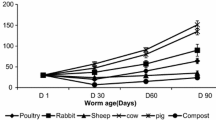Abstract
An outdoor study was undertaken using polyethylene containers to assess the suitability of different organic residues, soybean straw (Glycine max L. Merril.), wheat straw (Triticum aestivum L.), maize stover (Zea mays L.), chickpea straw (citer arietinum L.) and city garbage, as food for the tropical epigeic earthwormPerionyx excavatus, and to assess the influence of this earthworm on the decomposition of these materials. Maize stover was found to be the most suitable of the food materials used. Population growth ofP. excavatus was enhanced by addition of these organic materials in the temperature range 24°-30°C, while the population was adversely affected above 30°C in a vermiculture system. Addition of earthworms accelerated the breakdown of residues, which ultimately resulted in a lowering of the C:N ratio, water-soluble carbon and carbohydrates, and increased ash percentage and cation exchange capacity compared with their respective controls.
Similar content being viewed by others
References
Brink RH, Dybar P, Lynch DL (1960) Measurement of carbohydrates in soil hydrolysates with anthrone. Soil Sci 89:157–166
Edwards CA, Lofty JR (1977) Biology of carthworm, 2nd edn. Chapman and Hall, London
Garcia C, Hernandez T, Costa F, Ayas M (1992) Evaluation of the maturity of municipal waste compost using simple chemical parameters. Commun Soil Sci Plant Anal 23:1501–1512
Hallatt L, Viljoen SA, Reinecke AJ (1992) Moisture requirements in the life cycle ofPerionyx excavatus (Oligochaeta). Soil Biol Biochem 24:1333–1340
Kale RD, Bano K, Krishnamoorthy RV (1982) Potential ofPerionyx excavatus for utilizing organic wastes. Pediobiologia 23:419–425
Lax A, Roig A, Costa F (1986) A method for determining the cation exchange capacity in organic materials. Plant and Soil 94:349–355
Lee KE (1985) Earthworms: their ecology and relationship with soil and land use. Academic Press, Australia, pp 411
Morel J, Jacquin F, Gucket A (1979) Contribution a la determination de test de la maturite des composts urbains. C.R. Contrat, 75-124. Ministere de l'Environment et du Cadre de Vie. ENSAIA Nancy, p 32
Reinecke AJ, Viljoen SA, Saayman RJ (1992) The suitability ofEndocilus eugeniae, perionyx excavatus andEisenia fetida (Oligochaeta) for vermicomposting in Southern Africa in terms of their temperature requirements. Soil Biol Biochem 24:1295–1307
Waggoner PE (1974) The biochemistry and methodology of composting. Connecticut Agril Exptl Stn Bull 754, p 9
Walkley A, Black CA (1934) An estimation of the Digtjareff method for determining soil organic matter and proposed modification of chromic acid titration method. Soil Sci 37:29–38
Author information
Authors and Affiliations
Rights and permissions
About this article
Cite this article
Manna, M.C., Singh, M., Kundu, S. et al. Growth and reproduction of the vermicomposting earthwormPerionyx excavatus as influenced by food materials. Biol Fert Soils 24, 129–132 (1997). https://doi.org/10.1007/BF01420233
Received:
Issue Date:
DOI: https://doi.org/10.1007/BF01420233




